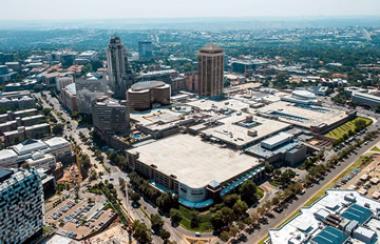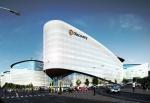Sandton Property Investment shows no sign of slowing down
 Interest in Sandton commercial property by investors is not slowing down as the financial and commercial hub of South Africa bristles with cranes, demolitions and new buildings.
Interest in Sandton commercial property by investors is not slowing down as the financial and commercial hub of South Africa bristles with cranes, demolitions and new buildings.
It is hard to believe that in the 1960s the greater Sandton area consisted of mostly semi-rural areas and was associated with horses and country estates.
The rush for commercial space began in the mid to late 1980s, when it was cheaper to buy land in Sandton, Rosebank and Parktown than in Johannesburg's central business district.
Sandton CBD is considered the richest square mile in Africa — and that was before its latest growth spurt. The financial and commercial hub of South Africa bristles with cranes, demolitions and new buildings.
Sandton is now set to overtake downtown Johannesburg in terms of commercial office space. The completion of the current pipeline will increase Sandton office supply to 1.7 million square metres , giving it the biggest stock of office space in the country.
Since 2012, more than 11 5000m² of new developments have been added, according to global real estate company Jones Lang LaSalle. The current development pipeline is 185 000m², of which more than 7 0000m² is due for completion this year.
There are concerns about the capacity to cope with additional traffic to the node. Between 8 000 and 10 000 more cars are forecast to enter the area once all developments are complete.
In the past year, vacancies in Sandton have shot up.
“Rents are stagnating, achieving limited to no growth in some cases,” said Ndibu Motaung, head of research at Jones Lang LaSalle South Africa.
“This is because occupiers are now presented with a wider choice of quality buildings and other competing nodes have cheaper rental and less traffic. But there are occupiers who insist on taking occupation in Sandton due to prestige, proximity to clients, and great infrastructure and amenities.”
The development pipeline is driven mainly by companies such as Sasol head office (67 000m²), Webber Wentzel (34 000m²) and Ernst & Young (3 3000m²).
Discovery is building the largest single commercial office development in Africa at 87 000m² — and 5 100 parking bays. It plans to move into the building in 2018.
“This is where all your financial people are and believe this is where they need to be,” said Marc Wainer, executive chairman of Redefine Properties. “People want to be there for the prestige.”
But, he said, there was already growing resistance to the area’s traffic congestion.
“The problem is if you go back 30 years or so, Sandton was full of smallholdings and the infrastructure was never designed to cope with what’s going on.
“If you talk to local authorities about making one-way streets, they’re not interested.”
Traffic lights are often out of order and just getting out of an office block can take ages.
It is not as if having more space available means it is any less expensive.
Sandton’s mean A-grade office space in the first quarter of this year was R150.83/m² compared with Rosebank at R127.50, Bryanston at R119.75 and Cape Town’s CBD at R105, according to Rode & Associates.
Luring lawyers and cohorts
LAW firms are springing up in Sandton or moving to newer, bigger premises at a rapid rate.
Whereas two decades ago most firms occupied one or two floors in a building in downtown Johannesburg, today many have moved into sprawling and glitzy premises, spurred by consolidation, the growing need for legal advice in an increasingly regulatory environment and more corporate activity.
Redefine Properties executive chairman Marc Wainer says the government is creating so much legislation that nobody knows what to do or when to do it, and competition for legal advice is thus stronger. Along with this, lawyers’ fees have escalated, spurring growth.
Rob Otty, MD of Norton Rose Fulbright, says legal firms have tended to have the same life cycles in terms of leases and many are now moving out of long-standing leases as a function of real growth.
He says law firms prefer to be close to clients, that everything is in walking distance and the Gautrain has made a huge difference, allowing easy access to the airport.
Norton Rose has been in its new building for four years of a 10-year lease. The law firm leases 16 000m² of the total 2 0000m² available.
Webber Wentzel will take 26 000m² in the central area of Sandton. Bowman Gilfillan will occupy 22 000m² of a three-building development. ENS is considering where to move in the district to bigger premises. Cliffe Dekker Hofmeyr recently moved to new premises in Sandton and Eversheds in Sandton is planning to move.
Adjacent nodes are also benefiting. Fluxmans is redeveloping offices in Rosebank.
Fashionable old gal pulls them in
LOVE it or hate it, you cannot ignore it. Sandton City is Johannesburg’s top shopping destination and its success shows no signs of abating.
Last year, it celebrated its 40th birthday and, like many of its shoppers do at this age, treated itself to a facelift.
Floor space was increased by 30 000m2.
When Rapp and Maister constructed the centre in 1973, it had about 40 000m2 of gross lettable area. This now stands at 141 390m2.
The potential was seen by the Liberty Group shortly after it was built.
The company has owned the centre ever since.
“We have seen a continued growth in tenant turnover, which shows in the tenant mix and changes to accommodate the brands favoured by our customers,” said Julie Hillary, general manager of the Sandton region for Liberty Properties.
“Sandton City has 26 entrances and more than 300 stores, and it is the leading brands that perform well.”
It has evolved into more of a fashion destination than a shopping centre and the new Diamond Walk, due to open early next year, will feature 10 of the top luxury brands in the world.
There are plans to upgrade the food court and the cinema level.
The centre has more than 8 000 parking bays and even so there are days when that does not seem sufficient.
There will be bicycle stalls and showers in the new office block of the Atrium to promote cycling.
This follows a trend prevalent in other major cities in the world.
Businesses in the area contribute money to allow dedicated traffic wardens to be deployed in the area.
This is essential because of the constant failure of traffic lights and subsequent congestion.





















